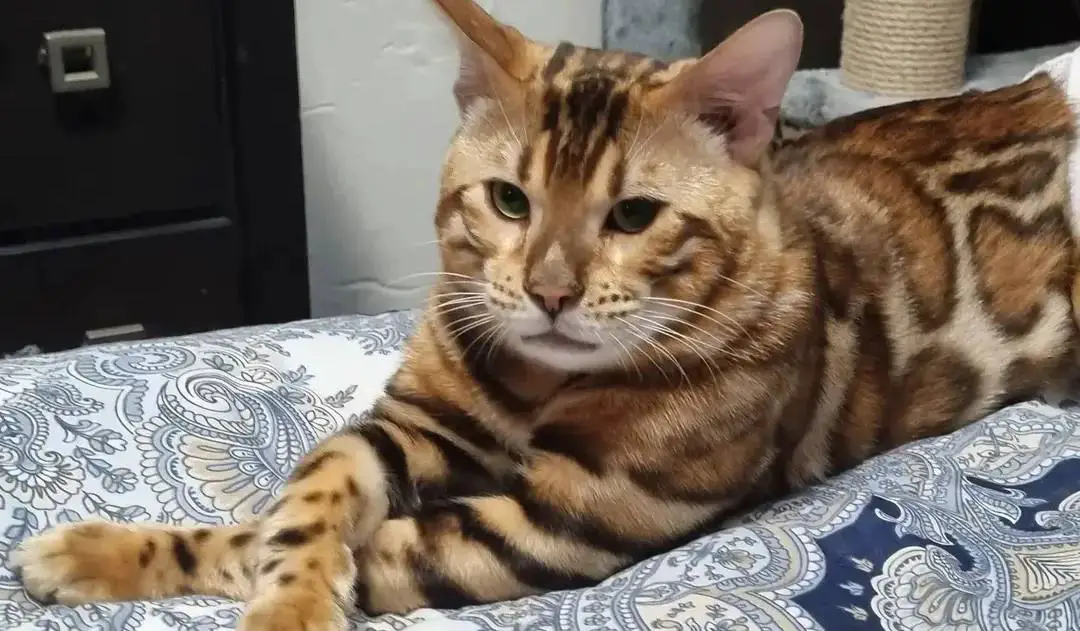Do you have a cheeky cat that seems to be in charge of the house? Disciplining your cat is the best way of fixing such a situation.
As a cat owner, I understand it can be frustrating to have a cat that constantly pushes down things from the shelves or scratches your furniture.
Disciplining your cat is something most cat owners don’t want to engage in, some dislike it, while others say it is good for the cat.
Since I’m among the cat owners who say it’s good to discipline your cat, let me share some effective ways of disciplining your cat!
Common cat behavior that requires discipline
Here is some common cat behavior you should discipline and not ignore:
- Pushing things off the shelves or counter
- Play aggression during play sessions
- Unnecessary biting
- Unnecessarily avoiding litter boxes or using the floor
- Scratching furniture excessively when bored
- Territorial and possessive behavior around other pets
- Unnecessary excessive vocalizations
- Your cat is peeing all over your home
- Your cat excessively soiling your house
- Cat attacking things around your house
You should also check out this article about entertaining your bored cat.
Effective Ways of Disciplining Your Cat

Based on my experience living with cats for many years, here are some of my effective ways of disciplining your cat:
Using a loud voice to scare your cat away when they misbehave
Using a loud voice to scare your cat away when they misbehave is one of the moderately effective ways of disciplining your cat.
When to use:
Using a loud voice is most effective for immediate and minor misbehaviors, such as scratching furniture or jumping on countertops. It serves as a quick deterrent and helps establish boundaries.
Benefits of using this method:
- Instant feedback and correction: Cats respond to immediate consequences, and a loud voice can provide instant feedback to stop undesirable behavior.
- Reinforces your authority: Cats recognize hierarchy and respond to assertive communication. Using a loud voice helps establish your role as the caregiver and leader.
- Prevents immediate damage or harm to property: By using a loud voice, you can deter cats from engaging in destructive behaviors, saving your furniture and belongings from damage.
Step-by-step process of how it can be done:
- Observe your cat’s misbehavior and assess the severity. Determine if it warrants disciplinary action.
- Take a deep breath and use a firm, commanding tone. The goal is to startle your cat and get their attention.
- Say a simple, sharp command such as “No!” or “Stop!” This serves as an immediate verbal cue to indicate their behavior is unacceptable.
- Maintain eye contact and use a loud voice to assert dominance. Cats rely on body language and vocal cues, so your tone and body language should convey authority.
- Follow up with redirection by offering an appropriate alternative behavior. For example, if your cat is scratching furniture, provide a scratching post nearby and encourage them to use it.
- Reward your cat with praise or treats when they comply with the desired behavior. Positive reinforcement helps reinforce the correct behavior.
Clapping your hands very loudly when your cat misbehaves
Clapping your hands very loudly when your cat misbehaves is a moderately effective way of disciplining your cat.
When to use:
Clapping your hands loudly is a useful technique for interrupting unwanted behaviors, such as excessive meowing or aggressive play. It startles the cat and redirects their attention.
Benefits of using this method:
- Immediate distraction and interruption: The loud noise created by clapping hands provides an instant distraction, diverting the cat’s attention from their misbehavior.
- Redirect focus to appropriate activities: By interrupting the unwanted behavior, you can redirect your cat’s attention to more suitable and acceptable activities.
- Prevents prolonged or escalating misbehavior: Clapping hands loudly can quickly stop the misbehavior before it escalates into a larger problem, ensuring a safer environment for both your cat and your belongings.
Step-by-step process of using this method:
- Observe your cat’s misbehavior and evaluate the situation. Determine if a loud noise is appropriate.
- Quickly and forcefully clap your hands together to produce a loud noise. The sudden sound will startle your cat and interrupt their behavior.
- Maintain eye contact with your cat to ensure they associate the loud noise with their misbehavior.
- Follow up with redirection by offering an appropriate alternative behavior. For example, if your cat is scratching the couch, redirect their attention to a scratching post.
- Reward your cat with praise or treats when they comply with the redirected behavior. Positive reinforcement encourages them to continue the desired behavior.
Put the cat on a 60 seconds time-out when they misbehave

Putting the cat on a 60-second time-out when they misbehave is a highly effective way of disciplining your cat.
When to use:
A time-out is most effective for persistent or serious misbehaviors, such as aggression toward humans or excessive scratching.
It allows the cat to calm down and reinforces the concept of consequences.
Benefits of using this method:
- Controlled environment for reflection: Placing your cat in a time-out area provides them with a controlled environment to reflect on their behavior. It allows them to calm down and understand that their actions have consequences.
- Reinforces the concept of consequences: By implementing a time-out, you establish clear boundaries and expectations for your cat’s behavior. They learn that certain actions lead to temporary isolation.
- Establishes clear boundaries and expectations: Time-outs help establish a structured environment where your cat understands what is acceptable and what is not. This clarity promotes a well-behaved and harmonious household.
Step-by-step process of using this method:
- Observe your cat’s misbehavior and ensure it warrants a time-out. Time-outs are best suited for persistent or serious misbehaviors.
- Gently and calmly pick up your cat and place them in a designated time-out area, such as a separate room or a carrier. Ensure the area is safe and free from potential hazards.
- Close the door or secure the carrier to restrict your cat’s movement and prevent them from leaving the time-out area.
- Set a timer for 60 seconds. This provides a consistent duration for the time-out period.
- After the time-out period, release your cat from the designated area and resume normal interaction.
- Offer positive reinforcement for good behavior to encourage your cat to engage in desirable actions.
Use motion-activated air sprays when your cat misbehaves
Using motion-activated air sprays when your cat misbehaves is one of the highly effective methods of disciplining your cat.
When to use:
Motion-activated air sprays are particularly effective for behaviors that require immediate correction, such as counter-surfing or entering restricted areas.
They work best when you cannot supervise your cat directly.
Benefits of using this method:
- Immediate and consistent correction: The motion-activated air spray provides immediate feedback, ensuring your cat associates the undesired behavior with a mild disturbance.
- Creates a negative association: The gust of air creates a deterrent effect, discouraging your cat from engaging in the behavior.
- Allows for redirection and positive reinforcement: By redirecting your cat’s attention to an appropriate alternative, you can reinforce good behavior and create positive associations.
Step-by-step process of using this method:
- Identify the specific behavior you want to discourage, such as scratching furniture or jumping on countertops.
- Set up a motion-activated air spray device near the area where the misbehavior occurs. These devices are equipped with motion sensors that detect your cat’s movement.
- When your cat engages in undesired behavior, the motion sensor will detect their movement and trigger a gentle burst of air.
- The unexpected gust of air startles the cat, creating a negative association with the behavior.
- Simultaneously, redirect your cat’s attention to a more appropriate activity or provide an alternative, such as a scratching post or a designated play area.
- Consistently reinforce and reward your cat with treats or praise when they engage in the desired behavior.
Redirect bad behavior immediately after your cat misbehaves
Redirecting bad behavior immediately after your cat misbehaves is one of the moderately effective methods of disciplining your cat.
When to use:
Redirecting bad behavior is most effective for minor misbehaviors or situations where immediate intervention can prevent escalation.
Benefits of using this method:
- Immediate interruption: By promptly redirecting your cat’s attention, you interrupt the undesired behavior and prevent it from becoming a habit.
- Teaches appropriate alternatives: Redirecting allows you to guide your cat towards more suitable activities, reinforcing positive behavior.
- Promotes positive reinforcement: By rewarding your cat for engaging in the redirected behavior, you encourage them to repeat the desired actions.
Step-by-step process of using this method:
- Observe your cat’s misbehavior and determine an appropriate redirection strategy.
- Immediately intervene by clapping your hands, making a loud noise, or using a sharp, assertive command like “No!” or “Stop!”
- Physically guide your cat away from the undesired behavior.
- Redirect their attention to a more suitable activity or provide an alternative that satisfies their needs, such as a scratching post or interactive toy.
- Praise and reward your cat when they engage in the redirected behavior.
Using a water bottle to spray the cat when your cat misbehaves

Using a water bottle to spray the cat when your cat misbehaves is a moderately effective method 9f disciplining your cat.
When to use:
Using a water bottle to spray your cat is most effective for behaviors that require immediate correction, such as scratching furniture or jumping onto countertops.
Benefits of using this method:
- Immediate negative association: The gentle spray of water creates a momentary discomfort that discourages the undesired behavior.
- Safe and non-harmful: The spray of water is a harmless deterrent that does not cause physical harm to your cat.
- Allows for redirection and positive reinforcement: By redirecting your cat’s attention to more appropriate behavior, you can reinforce positive actions while discouraging negative ones.
Step-by-step process of using this method:
- Keep a clean spray bottle filled with water handy.
- When your cat engages in undesired behavior, issue a verbal cue such as “No!” to let them know it’s unacceptable.
- Aim the spray bottle towards your cat, ensuring the water stream is gentle and directed away from their face.
- Give a quick and light spray towards their body, avoiding any harshness or punishment.
- Simultaneously, provide an alternative behavior or redirect their attention to a suitable activity.
- Remember to praise and reward your cat when they comply with the redirected behavior.
Correct your cat in the act and not after the act
Correcting your cat in the act and not after the act is a highly effective method of disciplining your cat.
When to use:
Correcting your cat in the act is most effective when you catch them engaging in undesired behaviors in real-time.
It allows for immediate feedback and helps your cat make the connection between their action and the correction.
Benefits of using this method:
- Immediate feedback: Correcting your cat in the act allows for immediate feedback, helping them understand which behaviors are unacceptable. This increases the chances of them modifying their behavior.
- Clear association: By addressing the behavior as it happens, you create a strong association between the unwanted action and the correction. This association helps your cat understand what is expected of them.
- Opportunity for redirection: Correcting your cat in the act provides an opportunity to redirect their attention to a more appropriate behavior. By offering an alternative activity, you not only discourage the undesired behavior but also reinforce positive actions.
Step-by-step process of using this method:
- Observe your cat’s behavior closely and identify any undesired actions or behaviors. This might include scratching furniture, jumping on countertops, or biting.
- As soon as you catch your cat engaging in the unwanted behavior, immediately intervene. Timing is crucial for your cat to understand the association between the behavior and the correction.
- Use a sharp, assertive verbal cue such as “No!” or “Stop!” to get your cat’s attention. Your tone of voice should be firm and commanding.
- Physically redirect your cat away from the undesired behavior or gently remove them from the situation. For example, if your cat is scratching the furniture, gently pick them up and place them near a scratching post.
- Reinforce positive behavior by praising and rewarding your cat when they engage in the desired behavior. Use treats, affection, or a clicker training method to reinforce their good behavior.
Setting boundaries and rules for your cat
Setting boundaries and rules for your cat is one of the most highly effective method of disciplining your cat.
When to use:
Setting boundaries and rules for your cat is an ongoing process and should be implemented from the moment you bring them into your home.
It is effective for shaping your cat’s behavior in the long term and creating a harmonious living environment.
Benefits of using this method:
- Establishes structure and predictability: Setting boundaries and rules provides your cat with a sense of structure and predictability, which can reduce stress and promote better behavior. Cats thrive in an environment where they know what to expect.
- Clear communication: By setting clear boundaries, you communicate your expectations to your cat, facilitating a mutual understanding. This helps them feel secure and confident in their environment.
- Promotes a harmonious household: When all members of the household are aware of the boundaries and rules, it creates a harmonious environment where everyone knows what is expected. This promotes a positive relationship between you and your cat.
Step-by-step process using this method:
- Establish clear boundaries and rules for your cat based on your household’s needs and expectations. This might include areas that are off-limits, specific feeding times, or behaviors that are not tolerated.
- Consistently enforce these boundaries by communicating with your cat through verbal cues, body language, and consistent reinforcement. Use the same commands or cues consistently to help your cat understand what is expected of them.
- Use positive reinforcement, such as treats and praise, when your cat adheres to the established boundaries. Rewarding good behavior helps strengthen the desired actions.
- Redirect your cat’s attention to appropriate behaviors when they display behaviors that go against the established rules. For example, if your cat is scratching furniture, gently guide them to a scratching post and encourage them to use it.
- Be patient and consistent in reinforcing the boundaries and rules to ensure your cat understands and follows them. Consistency is key in helping your cat learn the expected behaviors.
Using deterrents when your cat misbehaves
Using deterrents when your cat misbehaves is one of the best moderately effective methods of disciplining your cat.
When to use:
Using deterrents is effective for specific behaviors or areas where your cat consistently misbehaves. It serves as a reminder to avoid those areas or actions.
Benefits of using this method:
- Creates a negative association: Deterrents help create a negative association with undesired behaviors or areas, discouraging your cat from engaging in them. The unpleasant experience serves as a deterrent.
- Gentle and safe correction: Deterrents provide a non-harmful way to deter your cat, ensuring their safety while still discouraging the behavior. They do not cause physical harm to your cat.
- Promotes redirection and positive reinforcement: By redirecting your cat’s attention to a more appropriate behavior, you can reinforce positive actions while discouraging negative ones. This helps shape their behavior effectively.
Step-by-step process of using this method:
- Identify specific behaviors that require deterrents, such as scratching furniture, jumping on countertops, or entering restricted areas.
- Choose appropriate deterrents based on your cat’s preferences and sensitivities. This might include motion-activated sprays, double-sided tape, or scent-based deterrents. Make sure the deterrent is safe and will not cause harm to your cat.
- Strategically place deterrents in areas where your cat tends to misbehave, such as furniture corners or kitchen counters. This helps create an association between the undesirable behavior and the unpleasant experience.
- When your cat engages in the unwanted behavior, the deterrent will discourage them from continuing by creating an unpleasant experience. For example, if your cat jumps on the kitchen counter, a motion-activated spray will release a harmless burst of air that startles them.
- Simultaneously, redirect your cat’s attention to a more appropriate behavior or provide an alternative, such as a scratching post or designated play area. This helps redirect their focus and encourages them to engage in desirable actions.
- Reinforce positive behavior by praising and rewarding your cat when they engage in redirected behavior. Positive reinforcement helps solidify the desired behaviors.
To find out more about some common cat behavior problems click here.
Wrong ways to disciplining your cat

Here are some common blunders you should steer clear of when disciplining your cat:
- Pulling the tail of your cat as a form of discipline
- Yelling at your cat as a sort of discipline
- Never discipline your cat by forcing its mouth into its pee.
- Never discipline your cat by forcing its mouth into its feces.
- Do not leave your cat’s water dishes unattended as a form of discipline
- Your cat should never be thrown out the window as a form of discipline
- Never deny your cat food or water as a form of discipline
- Never beat up your cat as a form of discipline.
Related: Read more about why your cat is biting.
Conclusion
In summary, positive reward, consistency, and patience are necessary for cat discipline.
You can successfully train your feline buddy to behave better by employing gentle approaches like rewarding positive behavior, giving them appropriate outlets for their energy, and correcting their behavior.
Keep in mind that a well-mannered feline becomes a joyful and pleasant addition to any family.









